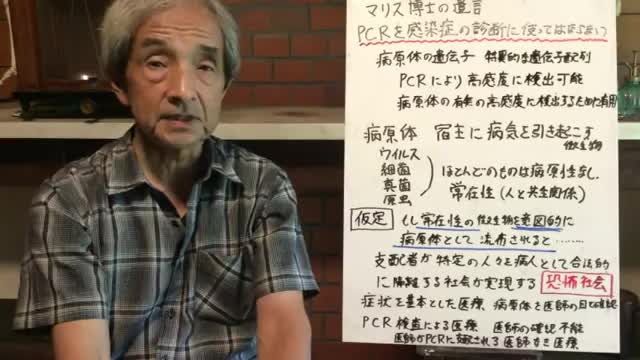【78】PCRの発明者 キャリーマリス博士の遺言を読み解く - 大橋眞
PCRの発明者キャリーマリス博士は、「PCRを感染症の診断に使ってはならない」という言葉を残して、謎の死を遂げました。彼の死を待っていたかのように始まった今回の騒動においては、マリス博士の遺言に反して、PCR検査が感染症の診断に使われています。病原体は、宿主のゲノムと異なった遺伝子配列を持っているために、病原体遺伝子の検出を特異的に行うことが出来る優れた方法のはずです。しかも、感度も極めて高いために、特異度、高感度な病原体検査が理論的には可能のはずです。それでは、一体何が問題だというのでしょうか。
通常病原体検出のための診断法の確立には、病原体の遺伝子の中で、特定の病原体に特異的な配列を検出するような設計を行います。これによって特定の病原体の遺伝子を検出し病原体の存在を知る有力な手掛かりにすることが出来ます。しかし、今回の騒動においては、ある研究者が病原体遺伝子を特定したわけではありません。中国のあるグループが、重症肺炎の肺から取り出した液体から、ウイルスのゲノム配列を決定した報告に基づいて、世界各国でPCR検査をするようになりました。やがて、一人のPCR陽性者が無症状期に接触した人から、同様にPCR陽性になったという科学論文が数編出されました。このことから無症状の人から感染する伝搬力が強い感染症の病原体であるというイメージがつくられました。しかし、前検査をやっていないために、もともと各人が持っていた常在ウイルスであれば、伝染性の病原体であるとは言えないのです。しかもその後に出された論文においても、病状の進行と局所での問題とするウイルス量の増加と関連するという記述も見当たりません。動物への感染実験も同様です。感染に用いたウイルスと動物内で増殖したウイルスの同一性の確認が取れていません。すなわち、問題のウイルスが病原体であるという証拠がどこにもないのです。このような事実から、問題のウイルスは、病原体ではなく、常在性のものであると考えるのが妥当です。
もし、中国のグループが発表した論文の遺伝子配列が常在ウイルスのものであれば、このような事態になることは容易に想像できます。しかもこのグループもこの遺伝子が病原体ウイルスの遺伝子であるとは断定していないのです。この論文を引用した他のグループが、病原体ウイルスであるという前提のもとに研究をした結果、無症状者からの感染という虚構が作られていったのです。
もし常在性ウイルスを病原体とみなして、感染症の診断にPCRを用いると、健康な人を隔離する手段として使うことも可能になります。無罪の人を自由に監獄に送り込むような隔離社会が出来るわけです。マリス博士の遺言は、このような意味が込められていると考えられるのです。
Dr. Kary Mullis, the inventor of PCR, died a mysterious death, leaving behind the words, "PCR should not be used to diagnose infectious diseases." Contrary to Dr. Maris's will, PCR tests are used to diagnose infectious diseases in this uproar, which began as if waiting for his death. Since the pathogen has a gene sequence different from that of the host genome, it should be an excellent method that can specifically detect the pathogen gene. Moreover, since the sensitivity is extremely high, it should be theoretically possible to test for pathogens with specificity and high sensitivity. So what's the problem?
Normally, in order to establish a diagnostic method for pathogen detection, we design to detect a sequence specific to a specific pathogen in the pathogen gene. This can be a powerful clue to detect the gene of a specific pathogen and to know the existence of the pathogen. However, in this uproar, one researcher did not identify the pathogen gene. A group in China has begun PCR testing around the world based on reports that have sequenced the viral genome from fluids taken from the lungs of severe pneumonia. Eventually, several scientific papers were published stating that one PCR-positive person came into contact with the asymptomatic period as well. This created the image that it is a pathogen of infectious diseases with strong transmission power that is transmitted from asymptomatic people. However, because we have not done any pre-testing, we cannot say that the indigenous virus that each person originally had is a contagious pathogen. Moreover, even in the subsequent papers, there is no description that it is related to the progression of the medical condition and the increase in the viral load that is a local problem. The same applies to animal infection experiments. The identity of the virus used for infection and the virus propagated in the animal has not been confirmed. That is, there is no evidence that the virus in question is the pathogen. Given these facts, it is reasonable to assume that the virus in question is resident rather than pathogen.
If the gene sequence of the paper published by the Chinese group is that of a resident virus, it is easy to imagine that this would happen. Moreover, this group has not determined that this gene is a gene for a pathogen virus. The other groups that cited this treatise conducted research on the premise that it was a pathogenic virus, and as a result, the fictional idea of infection from asymptomatic individuals was created.
If a resident virus is regarded as a pathogen and PCR is used to diagnose infectious diseases, it can also be used as a means of isolating healthy people. An isolated society can be created in which innocent people are freely sent to prison. Dr. Maris's will is thought to have this meaning.
-
 8:36:37
8:36:37
Right Side Broadcasting Network
5 days agoLIVE REPLAY: CPAC 2025 Day Three with President Donald J. Trump - 2/22/25
310K85 -
 1:05:34
1:05:34
The Big Mig™
10 hours agoConfirmed Kash Patel New FBI Director, Bring On The Pain |EP483
37.9K13 -
 53:59
53:59
Tactical Advisor
6 hours agoThe Vault Room Podcast 009 | Everyone Getting $5000?!
37.5K7 -
 2:04:44
2:04:44
TheAlecLaceShow
17 hours agoLive at CPAC | Interviews with Dean Cain, Rep. Comer and more! | The Alec Lace Show
57.2K3 -
 LIVE
LIVE
Major League Fishing
3 days agoLIVE Tackle Warehouse Invitationals, Stop 1, Day 2
202 watching -
 3:12:37
3:12:37
I_Came_With_Fire_Podcast
14 hours agoNOC Spy: CIA uses SATANIC RITUAL ABUSE to make SLEEPER Cells
38.9K9 -
 28:42
28:42
CatfishedOnline
1 day ago $2.43 earnedWoman Insists Morgan Wallen Relationship Isn't a Romance Scam!
36.4K1 -
 16:25
16:25
TSPLY
1 day agoNew CNN / MSNBC Meltdown Moments Of Getting Mad At Donald Trump In February
38.9K26 -
 8:33
8:33
scoutthedoggie
7 hours agoAirsoft War Games Scotland
56.2K7 -
 4:56
4:56
Kirill MultitoolOfficial
1 day ago $3.82 earnedSurvival TIPS and usefull bushcraft DIY in the wild
60K3
